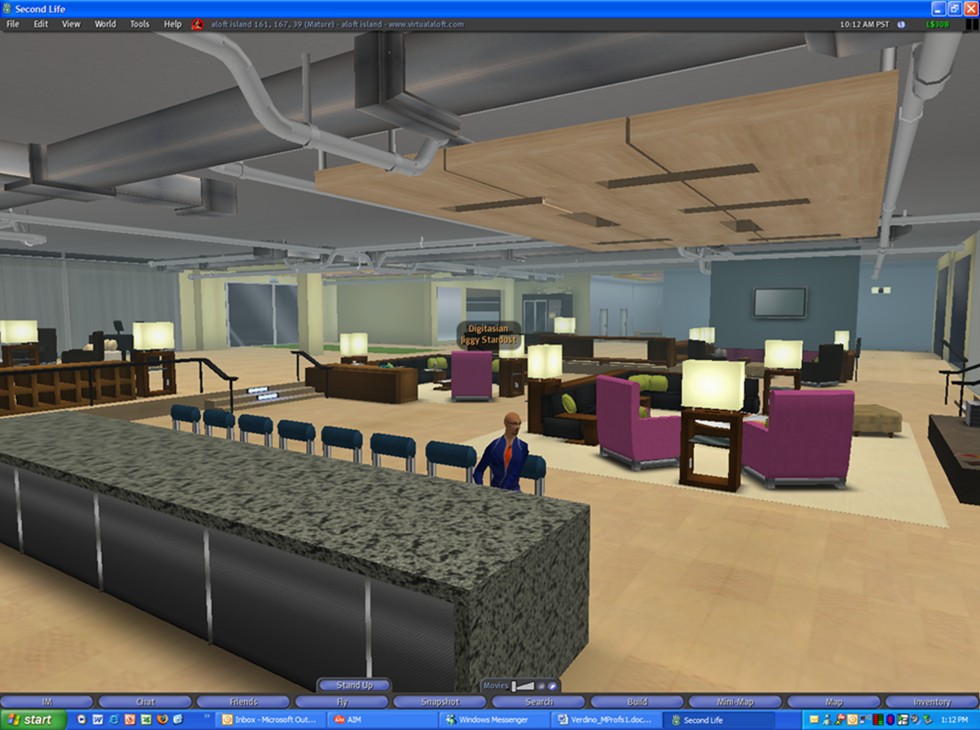I'm sitting in the chic lobby of Aloft, the groundbreaking Starwood hotel that has opened in the virtual world long before one opens in the real world. I'm alone at the bar, last stool on the left. I'd order a drink, but there doesn't seem to be a bartender on duty. I'd complain to the manager, but I can't find her, either. In fact, there isn't another soul in sight. No guests. No staff. It has been this way every time I've come for a visit.
Virtual Aloft is beautifully rendered. The attention to detail is amazing. But, still, it feels dead. This can't be what Starwood was going for when it started this marketing experiment.
Bored, I teleport to the American Apparel store. Empty, too. A sign next to the unmanned cash register reads FREE BEER. There's that drink I was looking for... but an offer of free beer from a youth-oriented retailer?
Actually, the sign and the cases of Tecate Mexican beer stashed behind the counter are the work of a rogue resident, an act of silent protest against Big Marketing's invasion of the virtual world. The beer has been there for months, along with a tray of steaming tacos and a piñata that hangs from the store's ceiling.
Toyota's Scion show room? Empty.
Reebok? Empty.
The Telus mobile phone store? Empty, too.
Welcome to Second Life, marketers. This is the vibrant virtual community that the business press is trumpeting as the new, new thing? The metaverse that companies are tripping over each other to infiltrate?
Linden, we have a problem.
Before you brand me a Luddite, I should tell you that The Next Big Thing is my stock-in-trade. I earn my keep advising clients on how to best leverage emerging media and technologies to meet their marketing goals. I believe in practicing what I preach, so I've also been leading a Second Life as a metaverse drifter, trying to understand what all of this really means.
As a marketer, it concerns me that many of the Second Life brand integrations stand empty most of the time. But as a Second Life resident, I don't want to spend time there, either. Where the marketer and resident meet, some guiding principles for more effective Second Life marketing emerge.
Let's look at a few of these.
You need to 'get it' before you 'get in'
I've spoken with a number of marketers and agency executives about Second Life. Many passionately assert that they need to establish an in-world presence now, and even bring a laundry list of ideas for exactly what they would like to do. I often inquire about how much time they've spent exploring the metaverse... and, more often than not, they haven't been in-world at all.
That, in itself, isn't so surprising. Two million people—the current population of Second Life—is actually a rather small group relative to the total population of Internet users. What is surprising is that so many companies are willing to make marketing decisions based mostly on what they've been reading in the press. You wouldn't open a store in a new region of the world without first conducting extensive market research, scouting location, and establishing clear business objectives. You need the same diligence here if you truly want to succeed.
Before making a move, you need to understand how people really spend their time in Second Life (or in any other metaverse you are considering), whether any of the in-world brand experiences you've been reading so much about have in fact been effective, and how residents are really spending their money in Second Life's virtual economy.
The best—maybe the only—way to understand the metaverse, is to join as a resident before you join as a marketer.
No brand is an island
You've heard about "brand islands"—a corporation buys an island on the Second Life grid and then fills it with an elaborate virtual experience, looking to attract residents from all over the metaverse.
This sounds a lot like the traditional Web marketing model, doesn't it? We build rich marketing experiences in the form of sites and microsites, then run advertising across a wide range of other Web properties in the hope of drawing visitors from where they already are to where we want them to be.
While that model has proven at least somewhat effective on the Web, it doesn't work in Second Life. There are no proven models for attracting meaningful traffic to brand islands, but that's just one reason most of these brand islands stand deserted. Second Life is vast. There is plenty to explore if you're in the mood for new experiences. There are plenty of places to settle in and simply chat with a few virtual friends (many long-time residents consider such small gatherings to be the essence of the Second Life experience.)
There is little reason to frequent many of the brand islands, as they exist today.
In fact, elaborate (and expensive) brand presences may actually send the wrong message. Second Lifers are leery of big marketers and fear that we will corrupt the virtual paradise they have created. They are fiercely loyal to the residents that operate grassroots, in-world businesses and are more than happy to demonstrate their loyalty with their Linden dollars (much of the $600,000 spent each day in Second Life changes hands among residents, not between residents and major marketers.)
To many Second Lifers, an expensive island presence brands your company as arrogant, as an intruder. This is why such islands are mostly deserted and others have been vandalized. Some marketers have even spurred in-world protests, simply for launching an in-world presence.
Second Life residents are in control. Instead of spending your marketing dollars to bring them products to buy, think about how you can spend those same dollars to bring them value and earn their attention. Instead of buying massive tracts of land and building your virtual headquarters or retail flagship, think about ways in which your company can enhance the core Second Life experience. Embed your brand into existing well-populated areas, give residents better ways to do the things they are already doing, or even support resident-run businesses.
The world is virtual but your expectations should be realistic
It seems that many marketers look at Second Life as a new way to connect consumers with their real world brands—and to separate consumers from their money. The logic runs: If you sample my products in the virtual world, then you may buy my products in the real world. I'm not sure that this logic holds.
As already noted, you are unlikely to attract significant traffic to your dedicated brand experience at this point, and residents aren't simply waiting to spend money on your virtual goods and services. Even carefully orchestrated, well-publicized marketer-sponsored events typically attract small audiences. Simply put, there is no scale in-world yet.
Even if you do crack the code and find a way to pull steady traffic, there is little evidence that Second Life residents bear any resemblance to the consumer population at large. Simple intuition would suggest that the in-world population skews heavily toward tech-forward early adopters.
This might be the perfect target audience for some brands, but until more demographic and lifestyle data becomes available, we shouldn't assume that Second Lifers are the same people who would buy our apparel, automobiles, soft drinks, or even CDs in the real world.
And what if you're just doing it for the buzz? You could argue that the press coverage garnered by early mover brands like Starwood, American Apparel, Adidas, and Reuters more than justifies the expense. Well, I think it's unlikely that we'll see Second Life hype of that magnitude any more, unless a brand does something truly world changing.
Don't get me wrong; I am excited by the opportunities the metaverse presents for marketers, and I do believe that Second Life is important, maybe more for what it represents and what it may become over time than for what it actually is today.
Depending on your point of view, Second Life represents the next frontier for online communities and consumer content creation, or it is an early precursor to 3D Web browsing. Quite likely, it is both.
Big changes are coming fast, and as marketers we would be well advised to learn some lessons about metaverse marketing now, lest we be trumped by more nimble competitors.
But we need to be smart about our approach, realistic in our expectations, and consumer-centric in our executions. Doing it just to do it isn't good enough.
On the other hand, neither is waiting to see what happens.





